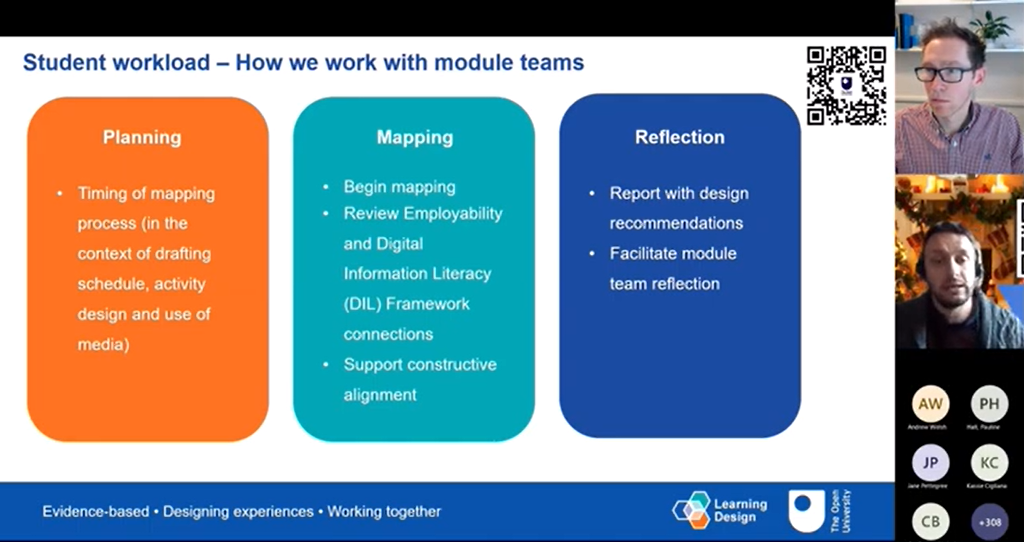Paul Astles and Catriona Matthews ~ Learning Designers
Scholarship can happen in unexpected ways and an opportunity can present itself when you least expect it. In this instance, a colleague from the Open University Library shared a call for content at a webinar series curated by the University of Kent. The theme of the event was around the role of the ‘learning designer’ in supporting student retention and success. We felt that this provided an excellent opportunity for us to share the role of the Learning Designer at the Open University and to specifically discuss how we support module teams in relation to student retention and success.
From that initial email pinging in it all happened quite quickly. We met to discuss our ideas about how to approach the topic, submitted a synopsis and waited to hear if we had been selected. It didn’t take long for our work to be reviewed and we received an email to confirm our place at the event a few days later.
Then the realisation set in that we had some to work to do. It was time to turn our synopsis into a fully formed output.
An overview of our talk “The role of Learning Design at The Open University in supporting student retention and success”
If you’d like to watch the video from our talk at the webinar, please take a few minutes to watch it on YouTube. It’s about 14 minutes long.
It is focused around three key areas:
- A brief overview of how real time student feedback is used within module presentations.
- The impact that course workload, specifically overloaded or unbalanced content, has on student retention.
- How we use a specialised tool to map student workload, activity types and constructive alignment.
The talk concludes by outlining the role that LDs play in the identification and implementation of design decisions, communicating outcomes with module teams and the application of one specific section of the ICEBERG model (developed by Open University researchers Jitse van Ameijde, Martin Weller and Simon Cross).
Some tips about how we have approached giving this talk online
We thought it would be useful to share some top tips in how to approach the process of creating a presentation for this type of purpose. It is hoped that this may inspire you to see beyond the mysticism of “presenting at an event” and provide an approach to planning that you can replicate and adapt for your needs.

Tip 1: Always have a safe space to share initial thoughts from your brain to the page. It doesn’t even need to make sense at first, just get those thoughts down and then you can reflect on them to see where you are at. Have a sounding board, this might be your fellow creator or a colleague. This will help you to refine your outputs when you are at a point that you feel ready to get some feedback on them. Don’t be afraid of waffling when you first put your thoughts down. This stage of the process is simply a brain dump.
Tip 2: No matter how short on time you might feel, always look at the literature or supportive evidence bank for the topic you are writing about. This will help to underpin your work with a solid foundation. To borrow an old adage, don’t build your house on sand because if you do it may not be built to withstand a storm (in this context the storm would be a peer review of your work from that sounding board I mentioned earlier).
Tip 3: You might hesitate to share something that is fairly standard practice for you. But what you think is mundane might be mind-blowing to someone else. For example, mapping workload on modules is a fairly large part of our job and because we do it regularly it can feel like old news. But we know all institutions work very differently so what is business as usual for us could be really interesting or helpful for someone else. So don’t be afraid to put forward a proposal which covers what you think is a boring topic.
Tip 4: Get creative with collaboration. Sometimes scholarship opportunities can fall at the most inconvenient times. In our case one presenter wasn’t available on the date of the talk. As well as collaborating on research and slide and script creation we decided to also create an asynchronous recording. This allowed both of us to present and created a great standalone set of videos we can use in the future.
Tip 5: Always get someone who hasn’t been involved in creating the talk to review your final product. Sometimes you’ve worked on something for so long you can’t see the wood for the trees. A fresh perspective can help you to finesse your talk and make it more coherent and understandable for someone who doesn’t know the subject inside out.
In our case some very kind colleagues suggested changes to our slide order and made the whole talk flow much better than before.
If you would like to watch the slide presentation on this topic, prepared by Paul and Catriona, you can view it on the OU Learning Design YouTube channel.
[Banner image via: Canva / JM_Image_Factory]

